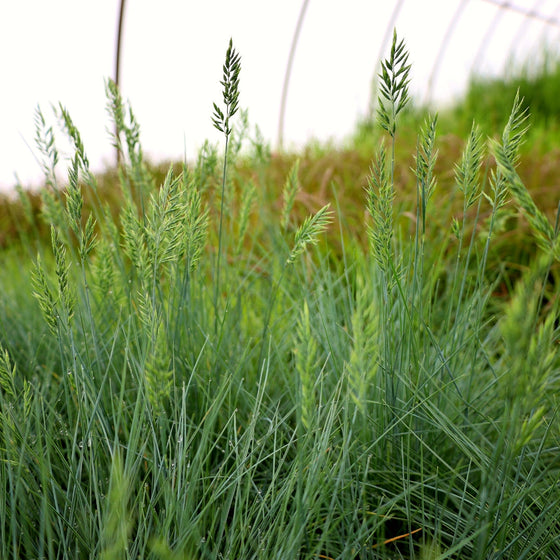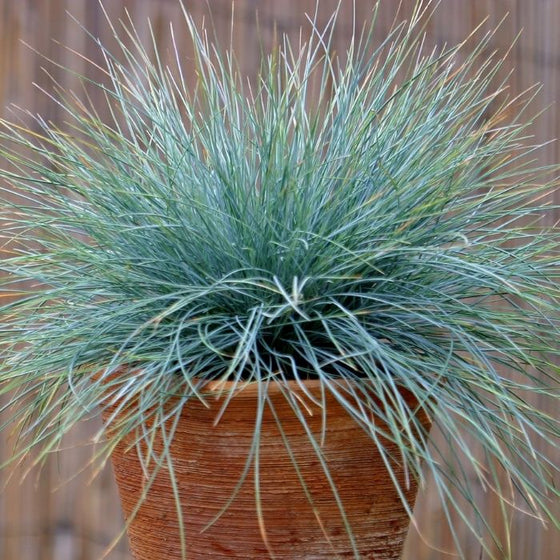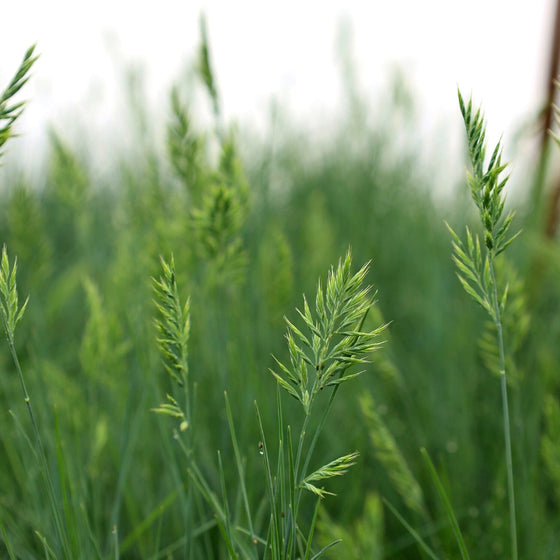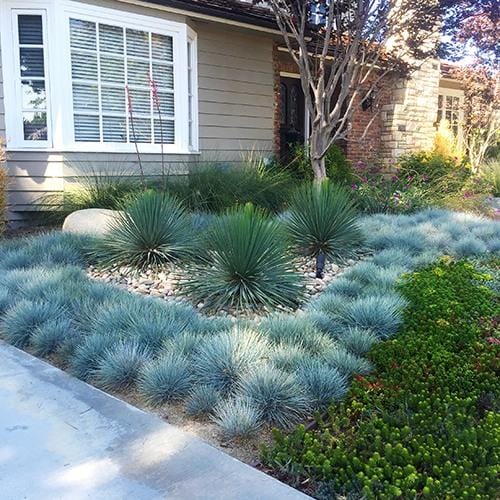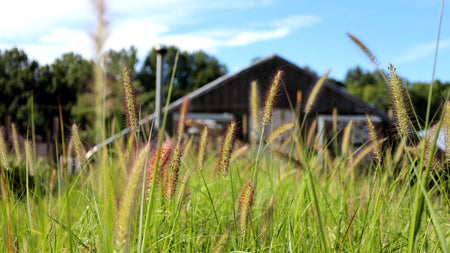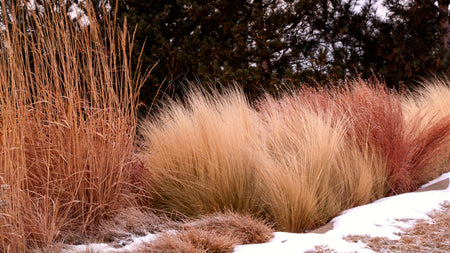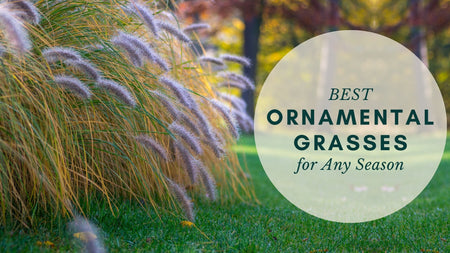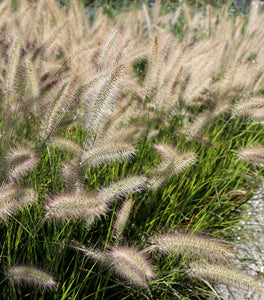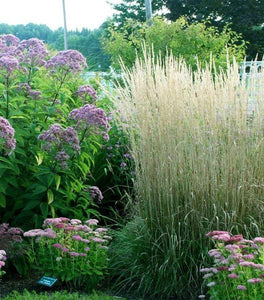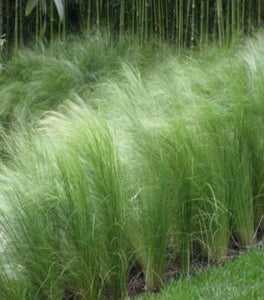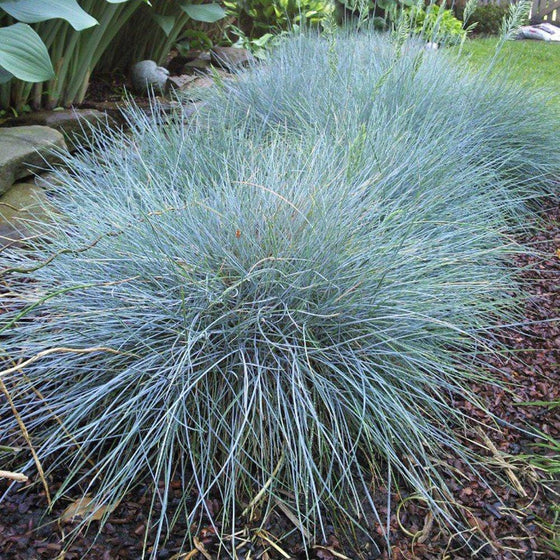
Images Depict Mature Plants
Elijah Blue Fescue for Sale Online
Elijah Blue Fescue (Festuca glauca 'Elijah Blue') is a popular ornamental grass known for its striking, icy blue foliage and compact size, making it perfect for adding year-round interest to any landscape. Its fine-textured, needle-like leaves form dense, rounded clumps that create a unique and attractive contrast in garden beds, borders, or rock gardens. This cool-season grass thrives in USDA Hardiness Zones 4-8, making it adaptable to a wide range of climates. In late spring to early summer, Elijah Blue Fescue produces delicate, buff-colored flower spikes that rise above the foliage, adding a soft, airy texture to its appearance.
Growing to a mature size of 8-12 inches tall and wide, Elijah Blue Fescue is ideal for low-maintenance landscapes where drought tolerance and easy care are essential. Its compact size makes it perfect for edging walkways, planting in containers, or creating mass plantings in sunny areas. This grass prefers full sun and well-drained soil, and once established, it is highly drought-tolerant, requiring minimal watering. The blue foliage retains its vibrant color throughout the year, making Elijah Blue Fescue an excellent choice for adding a splash of color and texture to any garden, even in the colder months.
In addition to its striking color, Elijah Blue Fescue is deer-resistant and low-maintenance, making it an excellent option for busy gardeners or those in areas prone to wildlife browsing. Its versatility allows it to blend beautifully with other perennials and ornamental grasses or as a ground cover in xeriscapes or dry gardens. Whether used as an accent plant, a border, or in mass plantings, Elijah Blue Fescue brings a unique, cool-toned beauty to any landscape design, providing year-round visual interest with minimal effort.
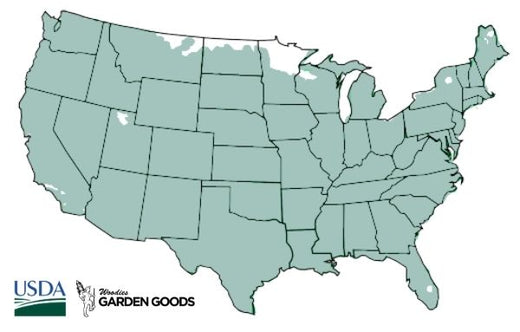
| Hardiness Zone: | 4-8 |
|---|---|
| Mature Height: | 8 to 10 Inches |
| Mature Width: | 12 inches |
| Classification: | Cool Season Ornamental Grass |
| Sunlight: | Full Sun to Part Shade |
| Habit: | Clump Forming |
| Foliage: | Powder Blue Color |
| Flower Color: | Tan |
| Pruning Season: | Cut down to 6 inches in the late winter / early spring |
| Soil Condition: | Prefers average garden soil |
| Water Requirements: | Water well until established |
| Uses: | Drought tolerant, ground cover |
How to Care for Elijah Blue Fescue
Be sure to read our planting instructions to ensure a healthy and happy Elijah Blue Fescue for years to come!
How Do I Plant Elijah Blue Fescue?
To plant Elijah Blue Fescue, choose a location that receives full sun and has well-drained soil, as this ornamental grass thrives in bright light and dry conditions. Begin by digging a hole that is about twice as wide and just as deep as the plant’s root ball. Place the plant in the hole, ensuring the crown sits at soil level, and backfill with the removed soil, gently firming it around the roots. Water the plant thoroughly after planting to help it settle in, but be cautious not to overwater, as Elijah Blue Fescue prefers slightly dry conditions once established. Spacing plants about 12-18 inches apart allows them room to grow and fill in beautifully. If planting Elijah Blue Fescue in containers, use a pot with good drainage and fill it with a well-draining potting mix. This grass performs well in container gardens, adding a vibrant pop of blue to patios, decks, or entryways. After planting, mulch around the base of the plant to retain moisture and keep weeds at bay, but avoid covering the crown. During the first growing season, water regularly to help the plant establish a strong root system. With proper care and planting, Elijah Blue Fescue will provide striking color and texture to your landscape for years to come.
How Do I Water Elijah Blue Fescue?
To properly water Elijah Blue Fescue, ensure the soil remains slightly moist during its first growing season to help the plant establish a strong root system. Water deeply once or twice a week, allowing the water to reach the root zone, especially during dry or hot periods. Once established, Elijah Blue Fescue becomes highly drought-tolerant and requires minimal watering. In fact, overwatering should be avoided, as this grass prefers dry to moderately moist soil. Always allow the top 2-3 inches of soil to dry out between watering sessions to prevent root rot and maintain healthy growth. For container-grown Elijah Blue Fescue, monitor the soil more frequently, as pots tend to dry out faster than garden beds. Water the plant when the top inch of soil feels dry, ensuring that excess water drains out of the container to avoid waterlogged roots. While this ornamental grass is drought-tolerant, it benefits from occasional deep watering during prolonged dry spells to keep the foliage looking vibrant and healthy. By managing watering properly, you’ll ensure Elijah Blue Fescue maintains its signature blue color and dense, clumping habit, making it a standout feature in your landscape or garden.
How Do I Fertilize Elijah Blue Fescue?
To fertilize Elijah Blue Fescue, apply a balanced, slow-release fertilizer in early spring as new growth begins to appear. A general-purpose 10-10-10 or 14-14-14 fertilizer provides essential nutrients, promoting healthy foliage and vibrant blue color. Spread the fertilizer evenly around the base of the plant, but avoid direct contact with the leaves to prevent burn. After fertilizing, water the area thoroughly to help the nutrients absorb into the soil and reach the roots. Elijah Blue Fescue is a low-maintenance grass, so one application in spring is usually sufficient for the growing season. If you prefer an organic approach, compost or well-rotted manure can be worked into the soil around the plant in early spring to provide a slow, steady release of nutrients. Avoid over-fertilizing, as too much nitrogen can lead to leggy growth and reduce the intensity of the blue foliage. For container-grown Elijah Blue Fescue, a diluted liquid fertilizer can be applied every 4-6 weeks during the growing season to keep the plant healthy and vibrant. Proper fertilization helps ensure Elijah Blue Fescue maintains its compact, clumping form and striking blue color throughout the year.

How Do I Prune Elijah Blue Fescue?
To prune Elijah Blue Fescue, the best time to do so is in late winter or early spring, before new growth begins. Using sharp garden shears or scissors, trim the grass back to about 3-4 inches above the ground. This annual pruning helps remove any dead or damaged foliage from the previous season, encouraging fresh, healthy growth in the spring. Pruning also prevents the plant from looking overgrown or untidy, allowing it to maintain its compact, rounded shape. Be sure to wear gloves, as the grass blades can be sharp and stiff. During the growing season, Elijah Blue Fescue requires minimal pruning, but you can remove any brown or damaged leaves as needed to keep the plant looking vibrant. Additionally, if the plant produces flower spikes that detract from its overall appearance, they can be cut back after blooming to maintain the focus on its signature blue foliage. Regular pruning not only enhances the aesthetic appeal of Elijah Blue Fescue but also promotes healthy growth, ensuring that this ornamental grass continues to provide year-round color and texture in your landscape or garden.

